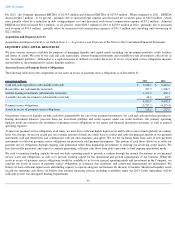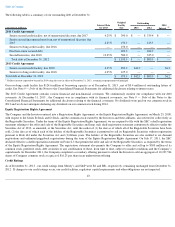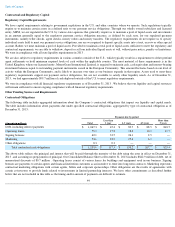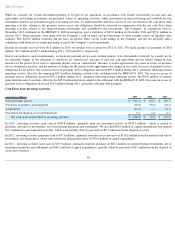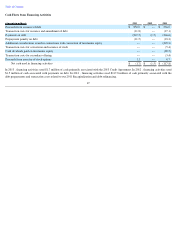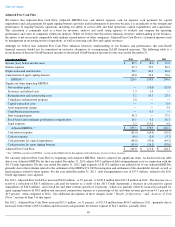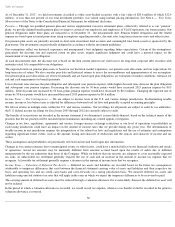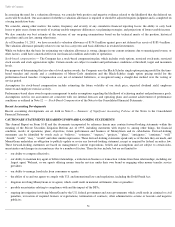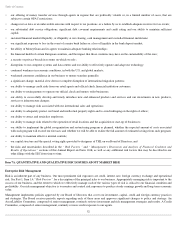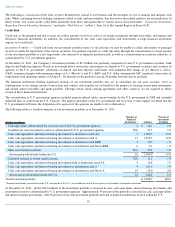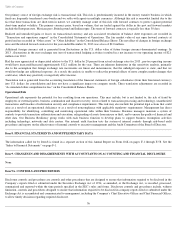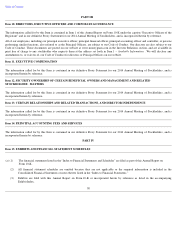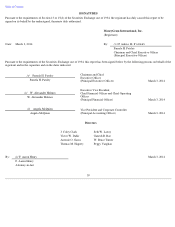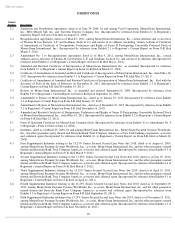MoneyGram 2013 Annual Report Download - page 52
Download and view the complete annual report
Please find page 52 of the 2013 MoneyGram annual report below. You can navigate through the pages in the report by either clicking on the pages listed below, or by using the keyword search tool below to find specific information within the annual report.
Table of Contents
As of December 31, 2013 , we held investments classified as other asset-backed securities with a fair value of $20.6 million of which
$12.4
million , or less than one percent of our total investment portfolio, was valued using internal pricing information. See Note 4 —
Fair Value
Measurement
of the Notes to the Consolidated Financial Statements for additional disclosure.
Pension
— Through our qualified pension plan and various supplemental executive retirement plans, collectively referred to as our “pension”
plans, we provide defined benefit pension plan coverage to certain of our employees and employees of Viad Corporation, our former parent. Our
pension obligations under these plans are measured as of December 31
, the measurement date. Pension benefit obligations and the related
expense are based upon actuarial projections using assumptions regarding mortality, discount rates, long-term return on assets and other factors.
Our pension plan assets are primarily invested in short-
term investment fund accounts and commingled trust funds issued or sponsored by the
plan trustee. Our investments are periodically realigned in accordance with the investment guidelines.
Our assumptions reflect our historical experience and management’
s best judgment regarding future expectations. Certain of the assumptions,
particularly the discount rate and expected return on plan assets, require significant judgment and could have a material impact on the
measurement of our pension obligation.
At each measurement date, the discount rate is based on the then current interest rate yield curves for long-
term corporate debt securities with
maturities rated AA comparable to our obligations.
The expected return on pension plan assets is based on our historical market experience, our pension asset allocations and our expectations for
long-
term rates of return. We also consider peer data and historical returns to assess the reasonableness and appropriateness of our assumption.
Our pension plan asset allocations are reviewed annually and are based upon plan obligations, an evaluation of market conditions, tolerance for
risk and cash requirements for benefit payments.
Lower discount rates increase the plan obligation and subsequent year pension expense, while higher discount rates decrease the plan obligation
and subsequent year pension expense. Decreasing the discount rate by 50 basis points would have increased 2013 pension expense by
$0.3
million . If the discount rate increased by 50 basis points pension expense would have decreased by $0.2 million
. Changing the expected rate of
return by 50 basis points would have increased/decreased 2013 pension expense by $0.6 million .
Income Taxes
— Tax Contingencies —
We are subject to income taxes in the U.S. and various foreign jurisdictions. In determining taxable
income, income or loss before taxes is adjusted for differences between local tax laws and generally accepted accounting principles.
We file tax returns in multiple states within the U.S. and various countries. Our tax filings for all periods are subject to audit by tax authorities;
the U.S. federal income tax filings for fiscal years 2005 through 2012 are currently subject to audit.
The benefits of tax positions are recorded in the income statement if we determine it is more-likely-
than not, based on the technical merits of the
position, that the tax position will be sustained upon examination, including any related appeals or litigation.
Changes in tax laws, regulations, agreements and treaties, foreign currency exchange restrictions or our level of operations or profitability in
each taxing jurisdiction could have an impact on the amount of income taxes that we provide during any given year. The determination of
taxable income in any jurisdiction requires the interpretation of the related tax laws and regulations and the use of estimates and assumptions
regarding significant future events, such as the amount, timing and character of deductions and the sources and character of income and tax
credits.
These assumptions and probabilities are periodically reviewed and revised based upon new information.
Changes in our current estimates due to unanticipated events, or other factors, could have a material effect on our financial condition and results
of operations. Actual tax amounts may be materially different from amounts accrued based upon the results of audits due to different
interpretations by the tax authorities than those of the Company. While we believe that our reserves are adequate to cover reasonably expected
tax risks, an unfavorable tax settlement generally requires the use of cash and an increase in the amount of income tax expense that we
recognize. A favorable tax settlement generally requires a decrease in the amount of income taxes that we recognize.
Income Taxes
— Valuation of Deferred Tax Assets —
Deferred tax assets and liabilities are recorded based on the future tax consequences
attributable to temporary differences that exist between the financial statement carrying value of assets and liabilities and their respective tax
basis, and operating loss and tax credit carry-backs and carry-
forwards on a taxing jurisdiction basis. We measure deferred tax assets and
liabilities using enacted statutory tax rates that will apply in the years in which we expect the temporary differences to be recovered or paid.
The carrying amount of deferred tax assets must be reduced through a valuation allowance if it is more-likely-than-
not the deferred tax asset will
not be realized.
In the period in which a valuation allowance is recorded, we would record tax expense, whereas a tax benefit would be recorded in the period a
valuation allowance is reversed.
50



